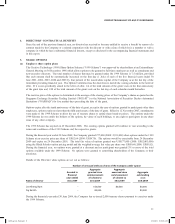Creative 2009 Annual Report Download - page 21
Download and view the complete annual report
Please find page 21 of the 2009 Creative annual report below. You can navigate through the pages in the report by either clicking on the pages listed below, or by using the keyword search tool below to find specific information within the annual report.
21
CREATIVETECHNOLOGYLTDANDITSSUBSIDIARIES
2.2 Group accounting
(a) Subsidiaries
Subsidiaries are entities (including special purpose entities) over which the Group has power to govern the financial and
operating policies, generally accompanied by a shareholding giving rise to a majority of the voting rights. The existence
and effect of potential voting rights that are currently exercisable or convertible are considered when assessing whether the
Group controls another entity.
The purchase method of accounting is used to account for the acquisition of subsidiaries. The cost of an acquisition is
measured as the fair value of the assets given, equity instruments issued or liabilities incurred or assumed at the dates of
exchange, plus costs directly attributable to the acquisition. Identifiable assets acquired and liabilities and contingent liabilities
assumed in a business combination are measured initially at their fair value on the date of acquisition, irrespective of the
extent of minority interest. Please refer to the paragraph “Intangible assets - Goodwill on acquistions” for the accounting
policy on goodwill on acquisition of subsidiaries.
Subsidiaries are consolidated from the date on which control is transferred to the Group. They are de-consolidated from
the date on which control ceases.
In preparing the consolidated financial statements, transactions, balances and unrealised gains on transactions between
group entities are eliminated. Unrealised losses are also eliminated but are considered an impairment indicator of the assets
transferred. Accounting policies of subsidiaries have been changed where necessary to ensure consistency with the policies
adopted by the Group.
Minority interests are that part of the net results of operations and of net assets of a subsidiary attributable to the interests
which are not owned directly or indirectly by the Group. They are measured at the minorities’ share of fair value of the
subsidiaries’ identifiable assets and liabilities at the date of acquisition by the Group and the minorities’ share of changes
in equity since the date of acquisition, except when the minorities’ share of losses in a subsidiary exceeds its interests in
the equity of that subsidiary. In such cases, the excess and further losses applicable to the minorities are attributed to the
equity holders of the Company, unless the minorities have a binding obligation to, and are able to, make good the losses.
When that subsidiary subsequently reports profits, the profits applicable to the minority interests are attributed to the equity
holders of the Company until the minorities’ share of losses previously absorbed by the equity holders of the Company are
fully recovered.
Please refer to the paragraph “Investments in subsidiaries and associated companies” for the accounting policy on investments
in subsidiaries in the separate financial statements of the Company.
(b) Transactions with minority interests
The Group applies a policy of treating transactions with minority interests as transactions with parties external to the Group.
Disposals to minority interests result in gains and losses for the Group that are recognised in the income statement. Purchases
from minority interests result in goodwill, being the difference between any consideration paid and the Group’s incremental
share of the carrying value of identifiable net assets of the subsidiary.
(c) Associated companies
Associated companies are entities over which the Group has significant influence, but not control, and generally accompanied
by a shareholding giving rise to between and including 20% and 50% of the voting rights. Investments in associated
companies are accounted for in the consolidated financial statements using the equity method of accounting less impairment
losses.
Investments in associated companies are initially recognised at cost. The cost of an acquisition is measured at the fair value
of the assets given, equity instruments issued or liabilities incurred or assumed at the date of exchange, plus costs directly
attributable to the acquisition.
AR09 pg1-64_Final.indd 21 10/2/2009 10:38:07 AM
























